ASUS Republic of Gamers and X79 ROG Review – Rampage IV Gene, Formula and Extreme
by Ian Cutress on August 3, 2012 1:00 PM EST- Posted in
- Motherboards
- Asus
- X79
- ROG
3D Movement Algorithm Test
The algorithms in 3DPM employ both uniform random number generation or normal distribution random number generation, and vary in various amounts of trigonometric operations, conditional statements, generation and rejection, fused operations, etc. The benchmark runs through six algorithms for a specified number of particles and steps, and calculates the speed of each algorithm, then sums them all for a final score. This is an example of a real world situation that a computational scientist may find themselves in, rather than a pure synthetic benchmark. The benchmark is also parallel between particles simulated, and we test the single thread performance as well as the multi-threaded performance.
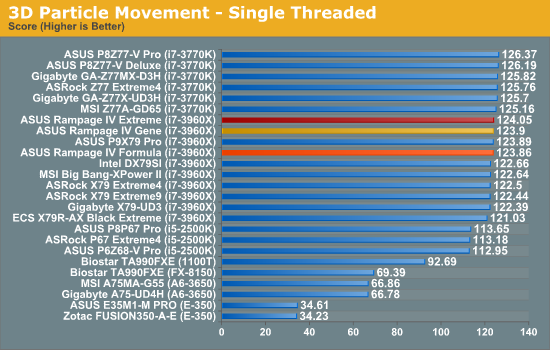
For single threaded performance, it looks like a stock i7-3770K outperforms a stock i7-3960X by less than 1%. With the right test, this is a consistent and repeatable difference.
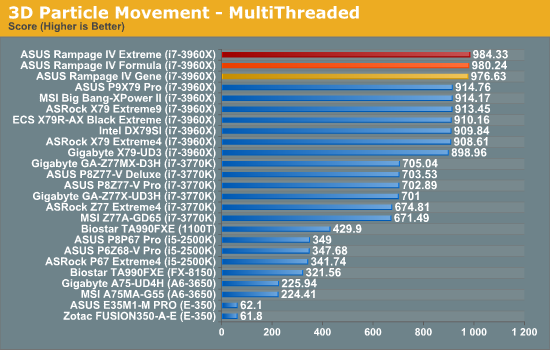
When it comes to multithreaded performance, ultimately six cores will outperform four cores, even with better IPC on four cores. The X79 ROG motherboards take this a stage further – by applying by default a small overclock on the processor. Similar to ASUS and Gigabyte Z77 products, the X79 ROG will use the top turbo multiplier in all loads.
WinRAR x64 3.93 - link
With 64-bit WinRAR, we compress the set of files used in the USB speed tests. WinRAR x64 3.93 attempts to use multithreading when possible.
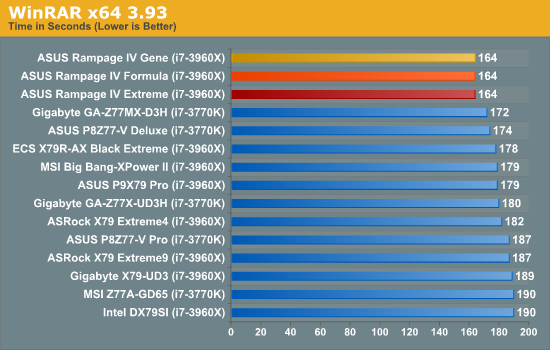
Due to the variable nature of WinRAR to use multiple cores, we would not expect that much of a difference on the ASUS boards. But it looks like the extra MHz under loading against the other X79 makes a difference, as well as quad channel memory.
FastStone Image Viewer 4.2 - link
FastStone Image Viewer is a free piece of software I have been using for quite a few years now. It allows quick viewing of flat images, as well as resizing, changing color depth, adding simple text or simple filters. It also has a bulk image conversion tool, which we use here. The software currently operates only in single-thread mode, which should change in later versions of the software. For this test, we convert a series of 170 files, of various resolutions, dimensions and types (of a total size of 163MB), all to the .gif format of 640x480 dimensions.
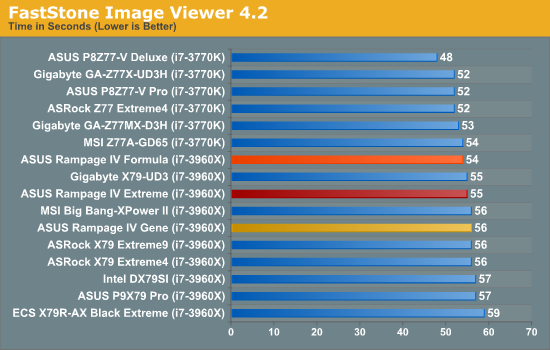
Being a single threaded test, the ROG motherboards perform well against X79 opposition. However, the Formula gets a little ahead over the Extreme and Gene.
Xilisoft Video Converter
With XVC, users can convert any type of normal video to any compatible format for smartphones, tablets and other devices. By default, it uses all available threads on the system, and in the presence of appropriate graphics cards, can utilize CUDA for NVIDIA GPUs as well as AMD APP for AMD GPUs. For this test, we use a set of 32 HD videos, each lasting 30 seconds, and convert them from 1080p to an iPod H.264 video format using just the CPU. The time taken to convert these videos gives us our result.
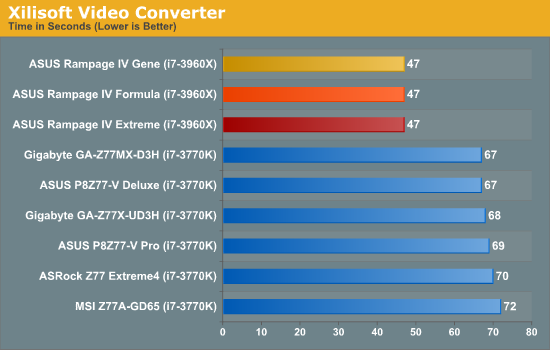
As expected from a multithreaded benchmark, six cores beat four. In addition, the increase in memory bandwidth will play a part here.
x264 HD Benchmark
The x264 HD Benchmark uses a common HD encoding tool to process an HD MPEG2 source at 1280x720 at 3963 Kbps. This test represents a standardized result which can be compared across other reviews, and is dependant on both CPU power and memory speed. The benchmark performs a 2-pass encode, and the results shown are the average of each pass performed four times.

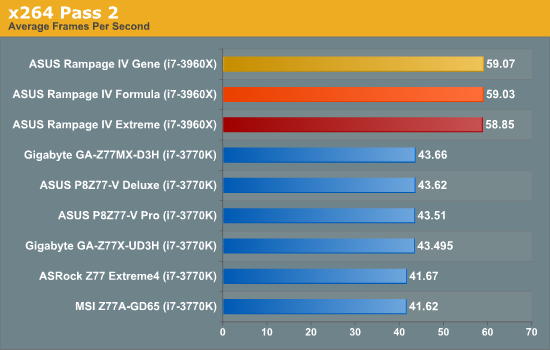










34 Comments
View All Comments
Flunk - Friday, August 3, 2012 - link
Ivy Bridge is more of a notebook oriented update anyway. The much better integrated graphics don't really matter to us anyway.G-Man - Friday, August 3, 2012 - link
Fantastic article, Ian! You must have been working on this for a long time. Thanks for a great read.B - Friday, August 3, 2012 - link
Ian -I would like to point out that under that nice metal Creative X-FI chip badge is, in fact, a Realtek processor. The Soundblaster piece of this is a merely a software implementation. I have this motherboard and was quite disappointed to discover this.
Thanks for great and thorough article.
just4U - Friday, August 3, 2012 - link
Indeed.. It's a little bit of a letdown. It will be nice if they are pushed away from the realtek chip now that Gigabyte is into similiar type boards which utilize the Creative recon chips.primonatron - Friday, August 3, 2012 - link
The article should be edited to specificy that it's only a Relatek chip, not a Creative one, at this point it's just blatent false advertising.When doing the review, did Anandtech actually do a Windows 7 install on it themselves?
They would have known if they did.
IanCutress - Friday, August 3, 2012 - link
As per my comment above, it states this in the tenth page. And yes, I do install Windows 7 fresh on every board I test. It would be crazy not to. I see the whole install procedure at least twice a week, as well as installing each vendors drivers and software. The ASUS install procedure for drivers is all one-button automatic, no user input required, no giant screens flashing up on the screen to ask to confirm this that or the other.Ian
primonatron - Friday, August 3, 2012 - link
I would not put " ASUS have dug into their pockets to provide the Gene with a better-than-Realtek solution, in the SupremeFX III" since it IS a Realtek solution.IanCutress - Friday, August 3, 2012 - link
Written in page 10:"In our SupremeFX III, we essentially get a Realtek codec (presumed ALC898), but by being stage III this chip is isolated from the rest of the board, has a separate EMI shield around the chip, its own PCB layer for audio tracing, a 1500 mF capacitor to reduce ripple, and gold plated audio jacks to minimize resistance. As a result, the SNR is increased to 110dB."
Ian
just4U - Saturday, August 4, 2012 - link
It also needs to be noted that soundchips getting decent software can be a fairly substantial bump.. atleast from my point of view. I seem to recall Creative nailing a company to the wall because they used software the emulated soundblaster stuff and they were reall popular 7 years back.just4U - Friday, August 3, 2012 - link
I've been using these for several years... and have always found that they offer more then most standard ATX boards in lesser and similiar price ranges. Your not paying the Big bucks but you have your foot in the door.. (as it were.. lol)They can be problematic at times mind you.. I've found that quality control can be a bit of an issue with dead boards coming in now and again. We are dealing with sensitive electronics mind you so that happens.
I must say they do have some competition now with Gigabyte's M3s sniper boards, that do utilize a true recon3d sound chip from Creative (as opposed to a realtek chip with software emulation). My hope is that it pushes Asus towards a similiar move as the sound is a key feature for these baby boards.
Personally I think the Gene series deserves your silver award. While high end boards can be had from all makers getting a good solid feature rich gaming MATX board is not the norm and they are almost allways a pleasure to work with.
Great review Ian.